On the afternoon of 24th November, 1864, a south-easterly gale blew up on the north east coast of England. The schooner, ‘Friendship’, carrying a cargo of coal, sailed into the mouth of the Tyne to take shelter, but ran aground on the notorious black midden rocks. As darkness began to fall, the steamship ‘Stanley’, on its way from Aberdeen to London, with 60 passengers and crew, and cattle and sheep on the deck, tried for shelter too but was also swept onto the rocks. The lifeboats from North and South Shields couldn’t get close due to the storm, so the only hope was the breeches buoy, a kind of harness attached to a buoy and hauled via ropes up the cliff. But only 3 people were rescued before the lines tangled and the rising tide meant that the rescue had to be called off until daylight. The Friendship broke up, losing all its crew and the Stanley tore in half.
As daylight came, thousands of local people had gathered on the cliff tops to watch the disaster. It became known that 32 crew, passengers and lifeboat men were killed in the wrecks. One of the people watching was a man called John Morrison, who believed that if local men were to volunteer to help the HM coastguard, many more lives could have been saved. A public meeting was held, with free tobacco given out to encourage attendance, and over 120 men signed up. The Tynemouth Volunteer Life Brigade was born. Soon, nearly every village had an organisation like it, all based on the TVLB rules. The TVLB is 150 years old this year and still running. The volunteers (22 men and 1 woman) are on call 24 hours a day every day of the year and all have day jobs as well. They still attend around 120 rescues every year.
This week, local people again lined the cliff tops to witness a rescue, but this time it was only a drill, to celebrate the TVLB’s birthday. As in the past, maroon rockets were fired to begin the drill, calling the volunteers to action. The bangs echoed around the cliffs and through the small village, creating cloudy puffs in the air. ‘Casualties’ waited nervously on a boat in the harbour, next to the pier. Even on this calm day, waves plumed over the pier, reminding us that in the days the TVLB was formed there was no pier to halt the waves. The drill was carried out in a sheltered bay named ‘the Haven’, but the black middens were just visible around the cliffs, licked by the high tide.
On the beach, the uniformed volunteers began to prepare the breeches buoy. In these days of helicopters, it’s now rarely used, but TVLB members are one of few organisations around the country still trained to use it. A rocket is fired to the ship in distress, attached to ropes and a buoy. The survivors on the ship secure the ropes to the vessel, ready for the breeches buoy to be ferried across. The breeches buoy is a life saving ring with a harness attached – like a pair of fluorescent breeches. The survivor steps into it and is hauled in to shore. No dramatic hoist up the cliffs on this rescue, but the ‘casualties’ were pulled through the water onto the beach. This isn’t a quick way to effect a rescue. Each passage takes around ten minutes, so I can only imagine what it must have been like to wait, on a stricken ship, for your turn to come. But without it, there would often have been no hope at all.
TVLB are based in the ‘watch house’ an wonderfully characterful building that is now a museum, filled to the brim with maritime memorabilia. Quirky, old-fashioned, a little eerie. The watch house is on the promontory above the mouth of the river and looks down on the black middens below. Keepsakes from the wrecks that prompted the start of the TVLB are among the items on show there. This celebration was a well-oiled drill, carried out on a calm day, with a ship that wasn’t in any danger. But if you were to walk around the watch house and study the things that are preserved there, you could easily imagine being on one of those ships, broken on rocks in the stormy dark, with no radios and no helicopters to aid you. I’m proud that it was here that this organisation began and I know that should I ever need them, they’ll be there to come to my rescue.
For those of you who receive the BBC’s ‘Coast’ TV programme, the drill was filmed by them on the day, with one of their presenters being ‘rescued’. The Watch House Museum has received lottery funding for refurbishment and is currently closed while it has a facelift.
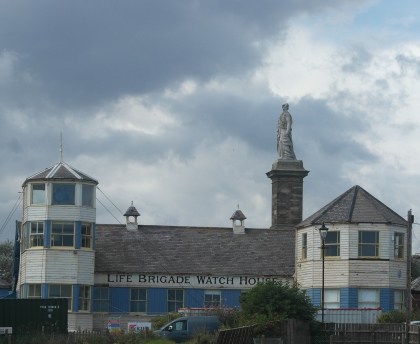
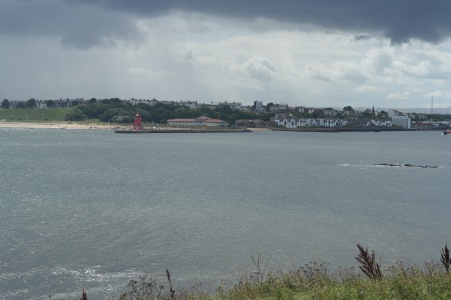
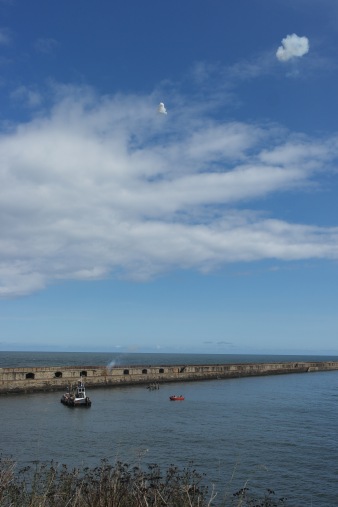
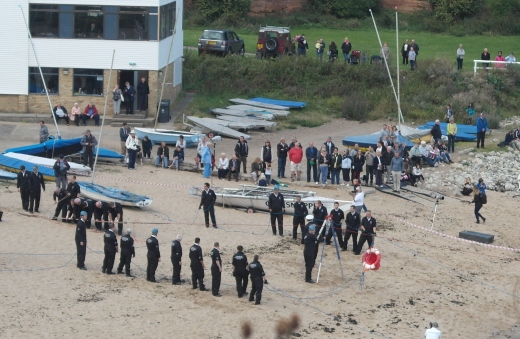

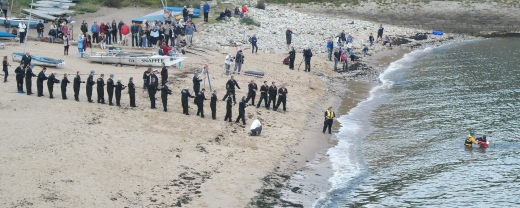
How interesting to learn about this. And how wonderful for people who volunteer their time like that to help others in need, especially when that help might mean endangering their own lives.
LikeLike
Yes, I think it takes someone special to do it, especially as well as a full time day job.
LikeLike
Andrea that was a chilling description of the tragedy. And a very interesting bit of history. The sea is such a powerful thing… Big hugs to you.
LikeLiked by 1 person
You can’t really imagine the scale of it and how terrifying it must have been, especially when they didn’t even have a radio to give the comfort that help was on its way.
LikeLiked by 1 person
It never ceases to amaze me how much coastal communities mobilise to do all they possibly can to help those in trouble at sea.
LikeLike
And all born from one person who thought, what else could we do to save more lives?
LikeLike
Great to live in a world where people have such thoughts.
LikeLike
Awesome blog post. Thanks for sharing it. The Watch House Museum was just added to my ‘locations to visit’ list.
LikeLike
Thanks Karen – it’s very atmospheric and lots of other interesting things nearby – I hope the refurbishment doesn’t lose any of the character.
LikeLiked by 1 person
If the refurbishment is in the right hands – this is certainly going to work, Andrea. After reading your blog post, I am looking forward to visiting this place.
LikeLike
That’s so interesting and, to think, that these people are volunteers.
At the time the organisation was founded, it must taken immense courage for the rescuers to venture out on stormy nights to save people from wrecks without helicopters or radios to aid them.
LikeLike
And the area was that much more treacherous then, Sarah, with no piers to protect the area where the danger was.
LikeLike
Nice bit of maritime history Andrea. The lifeboat stations around the British Isles and elsewhere do great work in the worst of conditions, risking and sometimes losing their own lives. (Had to laugh at the thought of free tobacco swinging the issue for some of the first volunteers).
And it’s good that the Watch House is looked after and the local community obviously take pride in it.
LikeLike
Thanks Roy – yes, we liked the touch of the free tobacco – it obviously worked 🙂 The watch house is one of those little museums, jam-packed with stuff, I’ll be interested to see it when the refurbishment is finished.
LikeLike
Andrea, this is a powerful and touching post. Thank you. On land, in the air and on the sea, those who risk their own lives to save others deserve our gratitude and respect. I read a story once about a shipwreck that took almost 200 lives. Only 6 survived, it said. I was in a h.s. psychology class, and the teacher had us skip ahead to “survivor guilt.” She concluded by saying that when we reach out to comfort and support the families of those who died in an accident or disaster, we must also do the same for those who survived. Their lives have been changed significantly, and they need help believing that their saved lives are precious and will make a difference.
LikeLiked by 1 person
Thanks Marylin – it was a touching celebration of the work they’ve done over the years – when the vicar read a prayer to bless the drill, it did hit home that though this was just a reconstruction, there are normally lives at stake. It’s interesting that your teacher focussed you on the survivors – I fear we do forget about them too often.
LikeLike
What a fascinating and touching piece of history. It also says much about human courage and commitment to help others, even in the face of risking their own lives. We need more such stories in the present time. Thanks for sharing this, Andrea!
LikeLike
Thanks Helga. They’re a relatively unsung organisation, but a very important one.
LikeLike
What a captivating post, Andrea. Kudos to John Morrison and all the volunteers. Volunteering to help others can change the world and it can make you feel pretty good too.
LikeLike
Thanks Jill, yes, so many lives saved since that tragedy through the efforts of volunteers.
LikeLike
Without folks like these volunteers life would be very different. How interesting to watch the reenactment – an event like this really brings home the dangers for all involved. Last night there was a piece on TV about the mountain rescue team in the Derbyshire Peak District. Again, all volunteers. How selfless some people are.
By the way, did you see Neil Oliver – Coast hasn’t been the same without him!
LikeLike
You wonder how many other lives would have been lost without them. No Neil Oliver I’m afraid 🙂
LikeLike
Ah … shame ….
LikeLike
He wouldn’t have wanted to get that hair of his wet… 🙂
LikeLike
Apparently he used to work as a lifeguard. See – I’ve checked him out!
LikeLike
🙂
LikeLike
I love the touch with the tobacco to get people to the meetings! This is a wonderful story Andrea, thank you for sharing this piece of history about how the TVLB was born. My mother worked for the RNLI for many years and used to tell me many stories of the bravery of the volunteers, all of whom had day jobs but were willing and able at a moment’s notice to jump in a lifeboat, often in dire circumstances, to help in the rescue. The museum must be a fascinating place to visit, a testimony to all the brave souls who helped so many. Volunteers of all kinds are everyday heroes 🙂
LikeLike
Your mother’s job must have been so interesting, to see first hand the bravery of the RNLI volunteers. You’re right, volunteers are everyday heroes 🙂
LikeLiked by 1 person
Andrea thanks for sharing your pictures and story. I take my hat off to all volunteers especially when it involves the sea. We would be lost without our lifesavers in Australia and I have a very strong respect for the sea. It is all powerful and not to be trifled with. Many people lose their lives because they do not understand the dangers.
LikeLike
Thank you Kath, much as I love the sea, it does have that power that can catch too many people of guard, so we need our volunteers.
LikeLike
Sad but also inspiring story, Andrea. I am constantly in awe of the men and women who brave all dangers to rescue people they have never met. When they are volunteers, the gift of their time, energy and possibly life is priceless. A lesson in absolute generosity for all of us. Beautiful photos to illustrate your post.
LikeLike
Thanks Evelyne. We shouldn’t forget all those who lost their lives in that tragedy or those before, but can only be thankful that something good came out of tragedy – and that we now have so many more resources to prevent tragedies like these.
LikeLike
It’s so great to see people volunteering like this. And so fascinating to learn the history behind the organization. I loved seeing the photos.
LikeLike
Thanks Letizia, it was great to see it in action, when no lives were actually at stake.
LikeLike
I had to smile when I read that people signed up to volunteer when free tobacco was offered! I think most of us want to volunteer our help, but we allow excuses to get in the way. Offering a freebie to entice more help is something to keep in mind! I’ll remember that the next time I’m cleaning out my garage. 😉
LikeLike
Yep, they obviously knew what their audience wanted – and it obviously worked 🙂
LikeLike
In this day and age, it’s wonderful to see that there are still so many men and women willing to risk their lives in order to help others. Thank you for reminding us that there are still good people in the world.
LikeLike
You do wonder at the altruism of some people to put their own lives in danger to save others – but there are so many unsung heroes and heroines who do it every day that there are more good people than we sometimes think.
LikeLike
What a wonderful account, Andrea! God bless the brave men!
LikeLike
Thanks Inese, yes – and one woman 🙂
LikeLiked by 1 person
Andrea, This is a wonderful informative post. You have a wonderful way of making me feel as though I’m with you watching the anniversary celebration.
LikeLike
Thanks Sheri, I’m glad you enjoyed the event 🙂
LikeLike
I feel like I am right there watching the celebration with you. Love the pics and the way you described everything that was going on. 🙂
LikeLike
Thanks Kourtney, it’s not something you ever see now so it was really interesting.
LikeLike